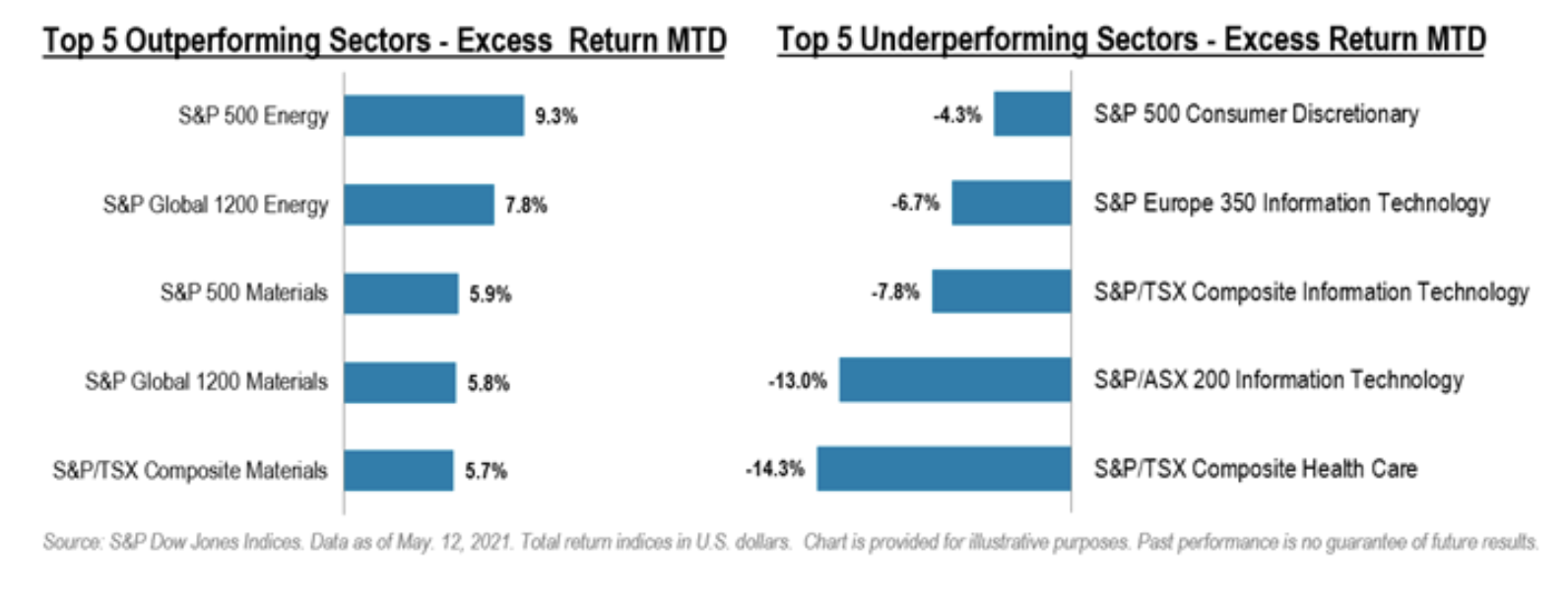Making sense of the markets this week: May 17, 2021
Tech stocks are struggling while commodities soar; Elon Musk changes his mind about bitcoin; plus, the relationship between bond rates and inflation (it may not be what you think).
Advertisement
Tech stocks are struggling while commodities soar; Elon Musk changes his mind about bitcoin; plus, the relationship between bond rates and inflation (it may not be what you think).

“According to economists, rising unemployment and high inflation (‘stagflation’) may be the result if the money supply is pumped too hard and fast by the authorities, especially if there is also a supply shock—a spike in the oil price, for example. The current massive U.S. fiscal and monetary stimulus, combined with soaring raw material prices, last Friday’s employment report shocker and yesterday’s eye-watering inflation print—MoM growth was the highest since 1982—have spooked the markets.”
BMO says inflation is more than just the base-year effects (we are starting from some pandemic-induced low prices from a year ago), and meaningful inflation appears more prevalent across a few recent timelines as well. Three-month inflation is at 5.6% annualized, and the 6-month rate is at 3.3% annualized. Thanks to Scott Barlow of the Globe and Mail for this tweet and numbers:And with the increase in inflation, your U.S. stocks won’t be making you any real return (inflation-adjusted), according to Liz Ann Sonders, the chief investment strategist at Charles Schwab. The real earnings yield has turned negative, and the real earnings yield for S&P 500 is at its lowest since 1981.BMO: "U.S. Inflation: It’s Not Just Base Effects" pic.twitter.com/VyTCtVYzmv
— Scott Barlow (@SBarlow_ROB) May 13, 2021
Perhaps that lack of real earnings is and will weigh on stock prices. As investors, we want to own real earnings, in tandem with earnings growth and revenue growth. A real U.S. stock market correction, including growth-heavy tech and the broad markets, would be a healthy event. That would allow investors in the accumulation stage to load up at lower price, and potentially with great current earnings. For those of us in the retirement, semi-retirement or near-retirement stage, those corrections are not useful if we’ve planned on selling shares (near-term) to create income. Once again, accumulators might root for a real U.S. stock market correction, and a return to real earnings. Lower prices are good. We’ll see if the markets can blow off the inflation scare from this week. And, that said, on Thursday, May 13, U.S. stocks were back in positive territory. In early Friday trading US stocks were adding on more gains. The next few weeks might send some strong signals. Does this correction have legs?S&P 500 real (inflation-adjusted) earnings yield has now fallen sharply into negative territory & is at its lowest since 1981 pic.twitter.com/OGv5risjdv
— Liz Ann Sonders (@LizAnnSonders) May 13, 2021
You can go to that live link on Longtermtrends to see a description of the chart, and the interpretation of real interest rates. Real interest rate is the rate of return that also factors in the inflation at the time. I’ll admit I would have guessed that a serious increase in inflation would be accompanied by short-term rising rates, at least. Central banks increase rates to keep a lid on growth and inflation. But that was not the case in the post-WWII recovery. I asked Phibrick for clarification on why rates stayed low in that period. He offered…yes – we faced this through the 1930s to the 1950s. This is where the term of transient inflation is stemming from.
— Mike Philbrick (@MikePhilbrick99) May 5, 2021
You can observe several periods where inflation spikes and interest rates do not – PLUNGING the real rate of return (blue line) negative.https://t.co/MtnyVkVsv3 pic.twitter.com/6SlMAv3WeG
“The bottom line is the central banks control interest rates and when they cannot afford to pay any higher amount of debt due to the [size] of the debt, they pin rates low. This is YCC, or Yield Curve Control being talked about. Post-Second World War, the situation on debt was similar—for example debt, was large and so rates were kept artificially low.”
Yes, we are in that same situation today; with their massive borrowing and printing of money, governments (and the world) cannot afford higher rates or higher borrowing costs. Philbrick added…“Also in WWII, there were many price controls put in place and as those price controls were removed, you saw sudden spikes in inflation in certain areas but rates were kept constant.”
Fascinating stuff. Will rates be kept “artificially low?” That would remove a partial inflation hedge—that of using short-term bonds to help in the fight against inflation. There was no full hedge during the stagflation of the 1970s and early 80s, but short-term bonds did offer some increasing income for much of the period. Of course, we cannot make a guess as to what will happen with short- or long-term rates. We can only protect with a basket of real assets, such as gold, commodities and real estate. Commodities stocks might help the cause as well. From S&P Global, here are the top-performing stock sectors for the month of May 2021 to date:
“The ransomware attack on the pipeline raised concerns that supplies of gasoline, jet fuel and diesel could be disrupted in parts of the region if the disruption continues…
“The pipeline carries gasoline and other fuel from Texas to the Northeast; its pipeline system spans more than 8,850 kilometres, transporting more than 380 million litres a day. It delivers roughly 45 percent of fuel consumed on the East Coast, according to the Georgia-based company.”
The Colonial Pipeline was shut down for six days, but has now reopened according to his CNN post. It will take several days for the pipeline service to return to normal. From the CNN post…“The restart can’t come soon enough. The shutdown sparked panic-buying and hoarding that has overwhelmed gas stations in the Southeast. A significant percentage of gas stations in Virginia, Georgia, North Carolina and South Carolina are without fuel, according to GasBuddy, which tracks fuel demand, prices and outages.
“Oil industry executives warned Wednesday that gas hoarding by Americans during the shutdown of the Colonial Pipeline is worsening the supply crunch.
“This situation is now being exacerbated by panic buying and hoarding,” Frank Macchiarola, an executive at the American Petroleum Institute, said during a press briefing.”
Cyber attacks can inflict considerable damage, and it’s a risk that investors might consider. Cybersecurity firms will become even more important, and perhaps more valuable in the coming years and decades. After the attack, we saw related cybersecurity stocks such as FireEye (FEYE), CyberArk (CYBR) and CrowdStrike (CRWD) experience significant price moves to the upside. Investor’s Business Daily offered up several cybersecurity contenders in the area. This might be another investable trend for core and explore money. I like undeniable investment trends, although this trend is very unfortunate, and part of an unfortunate reality.I’m still more than happy to be investing in bitcoin. (I discussed that post and bitcoin in a Moolala podcast with Bruce Sellery.) And, for the record, bitcoin is down by more than 10% for the week into Friday, May 14, and it has fallen by more than 20% over the last month. What a week it was. Dale Roberts is a proponent of low-fee investing who blogs at cutthecrapinvesting.com. Find him on Twitter @67Dodge.Ironic because no incremental energy is used in a #bitcoin transaction. The energy is used to secure the crypto-asset network, and the net impact on fossil fuel consumption over time will be negative, all things considered.
— Michael Saylor⚡️ (@saylor) May 12, 2021
Share this article Share on Facebook Share on Twitter Share on Linkedin Share on Reddit Share on Email
Mr. Roberts should clarify that buying Bitcoin and cryptocurrencies is not investing. It is speculating at best, gambling possibly, and at worst it is participating in the biggest pyramid scheme since Madoff.
Unfortunately, tons of people are blindly putting significant dollars into cryptocurrencies due to FOMO and they have no clue of the risks involved. If people want to put 2-3% of their portfolio into it, sure, but I’m hearing and reading about people putting 50-100%! And the history of manias shows us that’s going to end very badly for them.